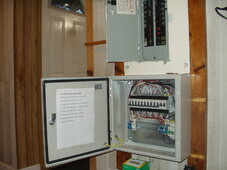RockOn
New Member
Thanks in advance folks for any comments.
Learning solar for both my house and my boat.
Hybrid grid and solar for my house BUT NOT tied to grid for any excess to flow back to utility.
Goal is to actively learn and in doing so cut a little off my electricity bill so here are the guidelines:
- 240v circuits will stay on grid power off the 200amp main panel
- 120v circuits will all be able to be on grid or solar through (2) 10 circuit transfer switches
Will try to run all non-240v circuits with my solar panels and batteries to see how much load I do end up with and if needed keep some on grid unless power outage.
Will obvious not be using any window air conditioners or the like either.
Attached is diagram but here is some info:
- (16) 325 watt panels in 2 (8) panel arrays - so each string is 368v, 2600 watts, 10.9 amps (can expand to twice this size as needed)
- (2) 10 circuit Reliance Transfer Switches for the 120v circuits (15 and 20 amp)
- (2) 3000watt 48v or 24v Hybrid MPPT controller/inverters (or also looking at one larger 5000 watt unit to feed both switches)
- (4) 48v 100ah LiFePo batteries or (4) 24V 200 batteries (20,480 watts)
I know panel array size not matching Inverter is breaking one rule if thumb, but would think based on battery bank size that this will be ok as both MPPT will feed a single bank and I can expand if/as needed.
I plan to use neutral/grounding scheme on page 2 as I may not run AC IN to the MPPTs and just leave them stand alone just connected to charge from solar.
Learning solar for both my house and my boat.
Hybrid grid and solar for my house BUT NOT tied to grid for any excess to flow back to utility.
Goal is to actively learn and in doing so cut a little off my electricity bill so here are the guidelines:
- 240v circuits will stay on grid power off the 200amp main panel
- 120v circuits will all be able to be on grid or solar through (2) 10 circuit transfer switches
Will try to run all non-240v circuits with my solar panels and batteries to see how much load I do end up with and if needed keep some on grid unless power outage.
Will obvious not be using any window air conditioners or the like either.
Attached is diagram but here is some info:
- (16) 325 watt panels in 2 (8) panel arrays - so each string is 368v, 2600 watts, 10.9 amps (can expand to twice this size as needed)
- (2) 10 circuit Reliance Transfer Switches for the 120v circuits (15 and 20 amp)
- (2) 3000watt 48v or 24v Hybrid MPPT controller/inverters (or also looking at one larger 5000 watt unit to feed both switches)
- (4) 48v 100ah LiFePo batteries or (4) 24V 200 batteries (20,480 watts)
I know panel array size not matching Inverter is breaking one rule if thumb, but would think based on battery bank size that this will be ok as both MPPT will feed a single bank and I can expand if/as needed.
I plan to use neutral/grounding scheme on page 2 as I may not run AC IN to the MPPTs and just leave them stand alone just connected to charge from solar.



